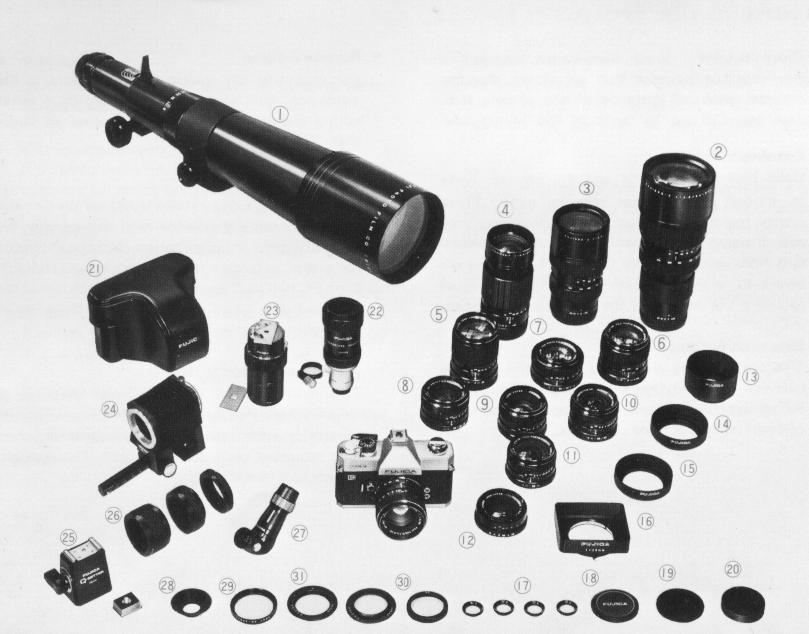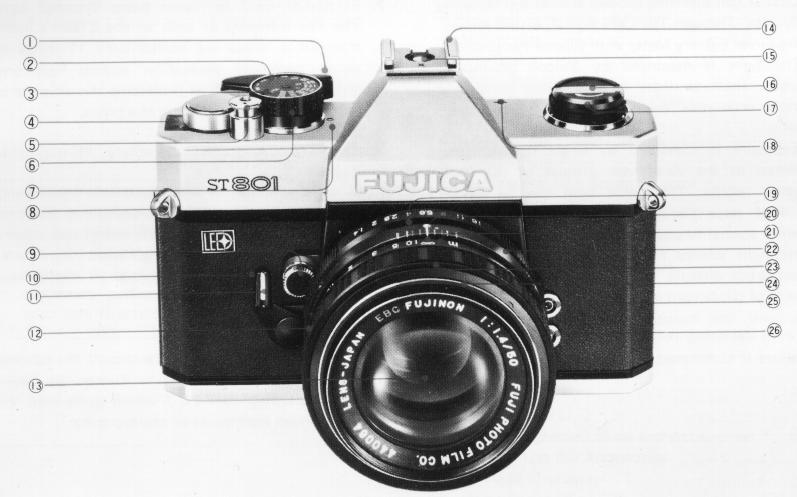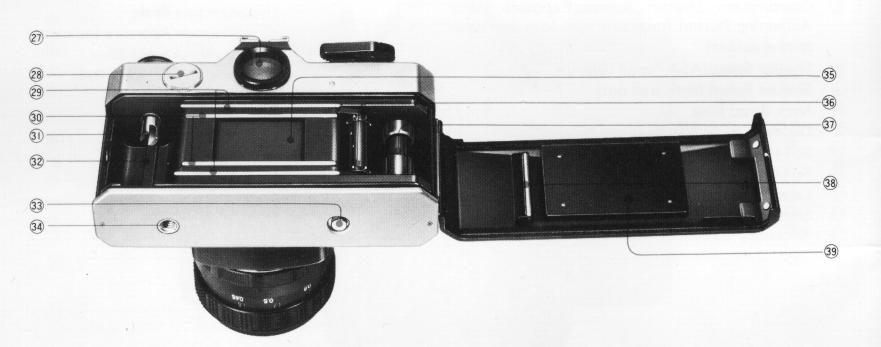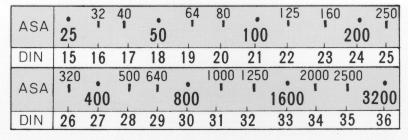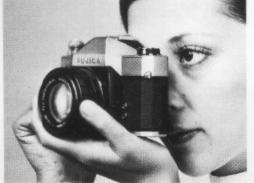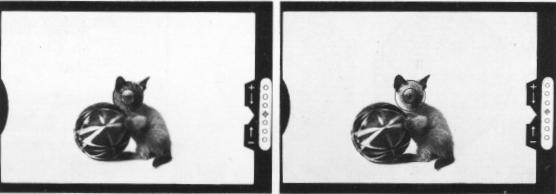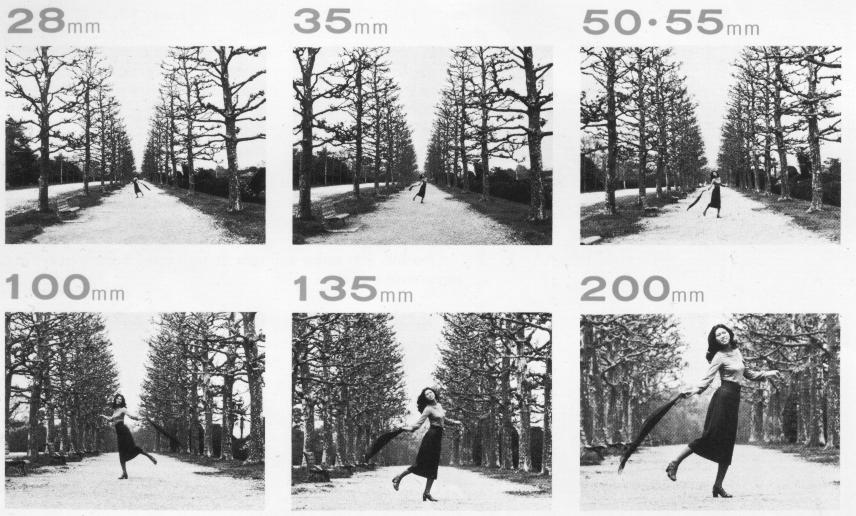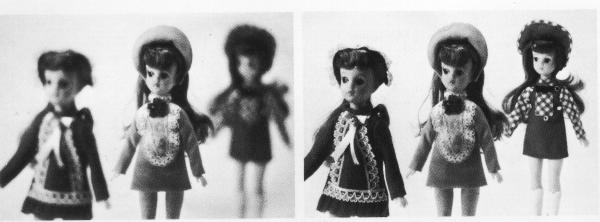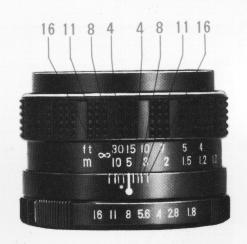On-line camera manual library.
CLICK HERE FOR A Fujica ST 801 PDF
MADE DIRECTLY FROM MANUAL
CLICK HERE FOR PDF VERSION OF
THIS SCANNED HTML MANUAL
CLICK BELOW FOR PDF OF OTHER LANGUAGES
Fujica ST801 Bedienungsanleitung
Fujica ST801 Mode D'Emploi
Fujica ST801 Manual de Instrucciones

Owner's Manual
This manual has been prepared to show you how to use the FUJICA ST801 correctly. Please be sure to read it over carefully to insure perfect pictures
from your very first roll.
CONTENTS
Versatile Features P 3
Names and Functions of Parts P 4
Specifications P 8 Part I-Basics
• Neck Strap and Carrying Case P12
• Loading the Battery P12
• Holding the Camera Steady P14
• Loading
the Film P16
• Setting the ASA Speed Selector P18
• Selecting the
Shutter Speed P19
• Focusing P20
• Exposure Control P21 |
• Shutter Release Button Lock P22
• Rewinding and Unloading P23 Part I
I-Advanced Techniques
• Changing the Lens P25
• Depth of Field P28
• Exposure Compensation P29
• Self-timer P31
• Use of Flash P32
• Interchangeable Lenses and Accessories . . P34
• How to Use the
Accessories P36
• Infrared Photography P38
• After Shooting P39 |
VERSATILE FEATURES
1. LED (Light Emitting Diodes)
Needle-less Metering System. Through-The-Lens Full Aperture Averaging Silver
Battery Meter with Silicon Photocells. The light is measured by Silicon
photocells, which react to light tens of times faster and more accurately than
conventional CdS photocells.
Exposure is indicated by seven light-emitting diodes in the viewfinder
instead of the usual meter needle. The diode light can be moved several steps
above normal exposure or below when special exposure effects are desired. Since
the light energy reflected from the subject is converted directly into
electrical energy in the form of diode light and no mechanical mechanism is
used, the exposure indication is quick and meter deviation caused by shock or
mechanical failure is eliminated.
2. FUJINON EBC (Electron Beam Coating) Lens The key elements of each of the
ST801's interchangeable lenses are coated with 11 layers to assure complete
protection against flare and ghost images as well as producing the ultimate in
color definition and picture sharpness.
3. The FUJICA ST801 Complete Photographic System
A wide selection
of interchangeable lenses ranging all the way from 28mm wideangle to 1000mm
ultratelephoto plus two zoom lenses and a complete set of carefully engineered
accessories bring every picture-taking situation within easy reach of everyone.
Part 1 Explains the basic operations of the camera. The reader is recommended
to master the basics before proceeding to Part 2 which deals with the more
advanced techniques of photography.
|
1• Film Advance Lever
2• Shutter Speed Selector Dial
3. Film Speed Window
4• Exposure Counter (automatic reset, additive)
5• Combination Shutter Release/Exposure Meter
6. Activating Button (provided with lock and cable
release socket)
7• Shutter Speed/ASA Speed Selector
7.1) Shutter Speed Mark (red dot)
8• Neck Strap Ring
9. Depth of Field Button (provided with lock)
10• Self-timer Start Button
11• Self-timer
12• Lens Safety Lock Release Button
13. Standard Lens
|
14. Accessory (hot) Shoe
15 Hot-shoe for X Contact
16 Film Rewind Crank
17 Film Rewind/Back Cover Lock
18, Film Plane Indicator
19 Aperture Scale
20 Distance/Aperture Indicator
21• Depth of Field Scale
22. Aperture Selector Ring
23. Distance Scale
24• Focusing Ring
25• FP Contact Socket
26. X Contact Socket
|
Click image to enlarge
|
27. Viewfinder Eyepiece
28• Battery Compartment
28• Film Guide Rail
30. Film Rail
31. Film Rewind Spindle
32. Film Cartridge Chamber
33. Film Rewind Button
34. Tripod
Socket
35. Shutter Curtain |
36. Sprocket Wheel
37. Film Take-up
Spool
38. Film Pressure Roller
39. Film Pressure Plate |
Click image to enlarge
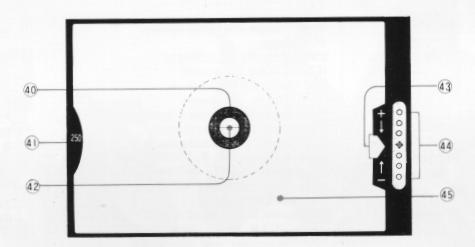 |
40. Microprism Focusing
41 Shutter Speed
42• Split-image Focusing
43• Exposure Indicator
44 Light-emitting Diodes
• Ground Glass
|
|
40 SPECIFICATIONS
|
|
Type:
|
35mm. single-lens reflex camera.
|
|
Picture Size:
|
24 x 36mm.
|
|
Standard lens:
|
EBC FUJINON 1:1.8 55mm.
|
|
Lens Mounting:
|
(4 component, 6 element) EBC FUJI NON 1:1.450mm.
(6 component, 7 element) Filter size 49mm., screw in type.
Screw in type (Praktica mount).
|
|
Shutter:
|
Mounting location locking device.
Focal plane shutter, B, 1-1/2000 sec., FP and X contacts, built-in
self-timer, hot shoe, safety lock equipped switch-on switch-off shutter release
button.
|
|
Viewfinder:
|
Penta-prism with Fresnel lens, 0.96x magnification (1:1.8 55mm.
lens). 2-way focusing with microprism and split-image, exposurecontrol light
emitting diodes (7) and shutter speed visible in viewfinder.
|
|
Mirror:
|
Quick-return.
|
|
Exposure Control:
|
TTL silicon photocell and light emitting diode metering system, averaging
light measurement through full aperture and stopped down aperture, aperture and
shutter speed interlocked with exposure meter, switch-on switch-off with shutter
release button, built in large scale intergrated circuit. .EV 1-19 light
measuring range, adjustable to.
ASA 25-3,200.
|
|
Silver battery power source (one 6-volt battery. Malory PX28, Eveready No.
544).
|
|
Film Advance:
|
Single-stroke lever action, 193 winding
angle, winding latitude provided by lever |
Dimensions & Weight:
5 1/4(L) x 3 7/8(H) x 3 1/2(D) in.133)L) x 91)H) x 88)D) mm (with
1:1.8, 55mm normal lens) 1.83 lb. (830g) (with 1:1.8, 55mm normal lens) 1.401b.
(635g) (body alone)
Accessories
Carrying Case, Neck Strap.
Optional Extras
Leather Case, Eye Cup, Eyesight Adjustment
Lens, Lens Hood, Right angle Finder, Close-up Lens, Extension Tubes,
Microscope Adapter,
Leica Mount Adapter, Reverse Adapter, Bellows Extension, Macrocinecopy.
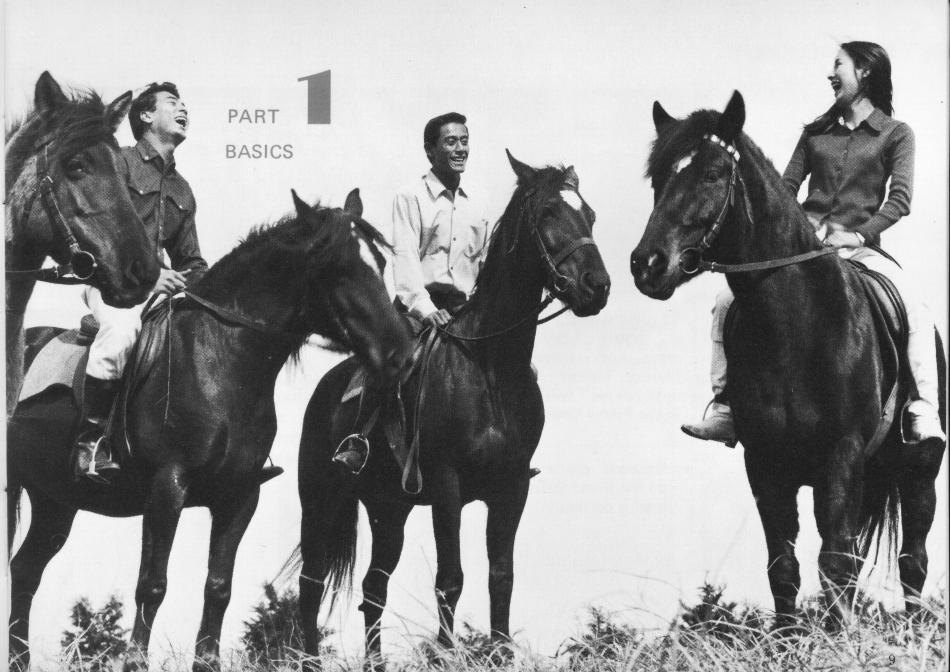
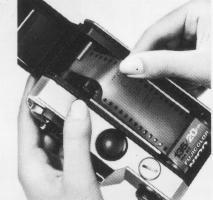 |
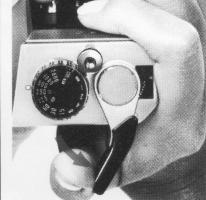 |
1. Pull up the Combination Film Rewind Crank/Back Cover Lock.
Open the
Camera Back Cover and Load the film. |
2. Wind the Film Advance Lever and press and
release the Shutter Release Button until you see 1 (white dot) in the Frame
Counter |
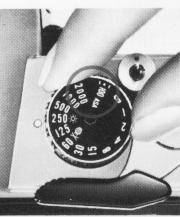 |
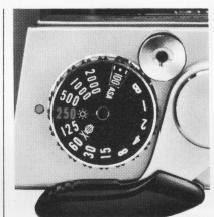 |
| 3. Set the ASA Film Speed. |
4. Select the Shutter Speed. |
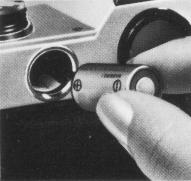 |
* Recheck the + and - of the Silver Battery
and load it correctly. |
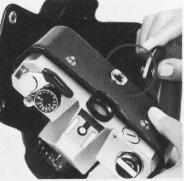 |
* Remove camera from Leather Case when you
are going to load the Film or Battery. |
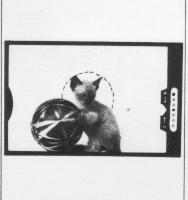 |
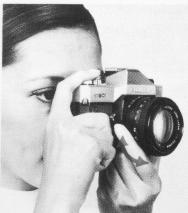 |
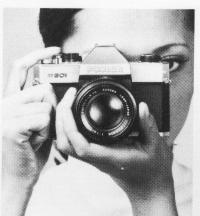 |
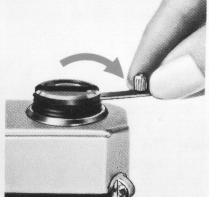 |
| Focus the Lens and Frame Your Picture. |
Touch the Shutter Release Button very
lightly. You will see the Red Diode Light on the right of the Viewfinder. Set
the exposure by turning the Aperture Selector Ring. |
Hold camera steady and gently press the
Shutter Release Button. |
After you have exposed the entire roll of
film, press the Film Rewind Button, pull up the Film Rewind Crank,
and turn it in the direction pointed by the arrow and wind the film back
into the cartridge, until
you feel tension released.
Next, lift the
Back Cover Lock fully up until the camera back snaps open,
now, remove the cartridge. |
NECK STRAP AND CARRING CASE
|
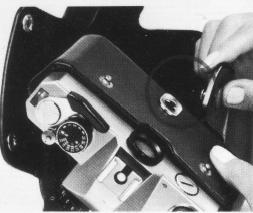
|
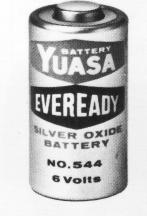
|
|
The Neck Strap is attached to the Neck Strap Ring.
The camera is fixed to the Carrying Case with the screw provided in the
bottom of the case.
Note: The camera is taken out of the case for film loading and unloading.
|
ADDING THE BATTERY
(1) The battery you need is a 6V silver battery (Eveready No. 544 or Malory
PX28).
(2) Under normal conditions, silver battery lasts for about one year.
(3) If the battery is exhausted, the red diode light in the Viewfinder will
not turn on.
|
(4) Wipe the battery clean with a piece of cloth before loading.
(5) Always remove the battery from the camera if you do not use it for a long
time.
(6) Do not try to disassemble, short-circuit, or discard into a fire.
(7) Always lock the Shutter Release Button when you do not use the camera,
otherwise the Battery Life will become very short. (See instructions in shutter
release section.)
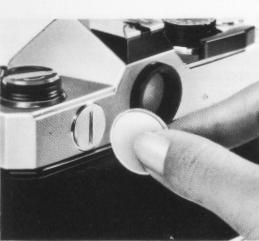 |
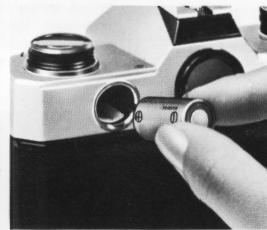 |
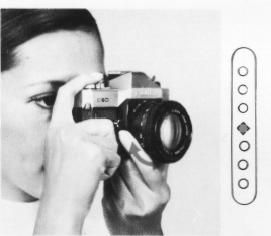 |
| 1. Open the Battery Compartment Cover. |
2. Load the battery and replace the cover. |
3. Look through the Viewfinder and touch the
Shutter Release Button very lightly. If you see a red diode light on the right
hand side, the battery is properly is properly inserted. |
|
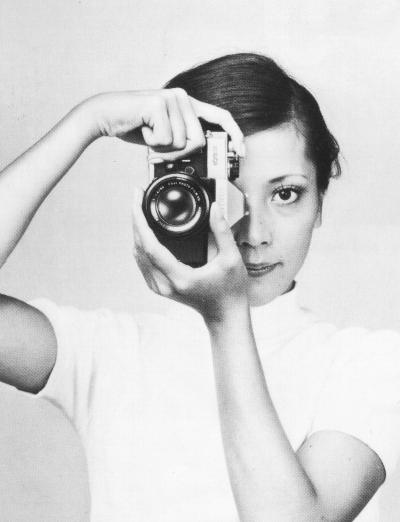
|
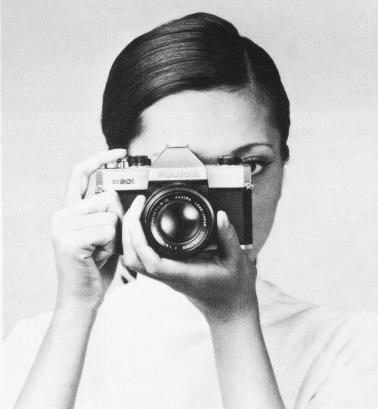
|
Before going into the mechanics of
picture-taking, remember that holding the camera steady is an important basic of
good photography. Camera movement results in blurred pictures. |
LOADING THE FILM
Be sure to load and unload the film
in the shade avoiding direct sunlight.
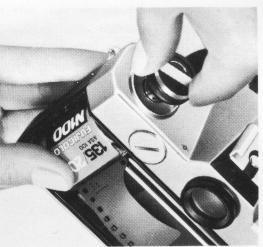 |
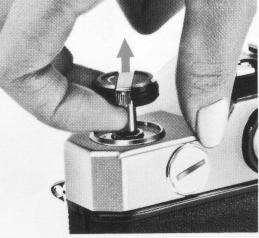 |
|
(1) Open the Back Cover by lifting up the Film Rewind/Back Cover Lock.
|
(2) Load the cartridge and press
down the Film Rewind/Back Cover Lock. |
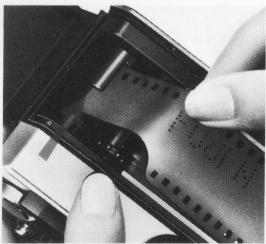
|
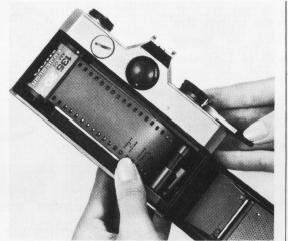 |
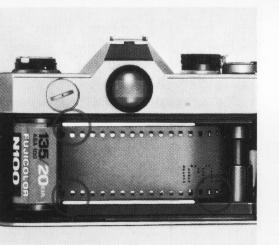 |
| (3) Pull out the film and insert it deeply into one of the slots
provided on the Take-up Spool. |
(4) Pull the film taut with the Film Advance Lever and make sure
that the sprocket teeth catch the perforations of the film. |
(5) Be sure the film rests between the Guide Rails and then
close the Back Cover. |
2. FILM ADVANCE
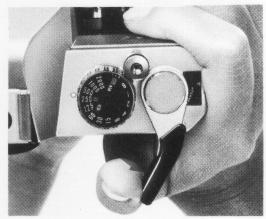 |
Wind the Film Advance Lever and press down the Shutter Release Button. Repeat
once or twice until the first white dot on the Exposure Counter moves directly
opposite the start mark. 1. To advance the film, just wind the Film Advance
Lever as far as it will go and release it. It will return by itself.
2. The film is properly loaded if the Film Rewind/ Back Cover Lock turns in
the direction opposite that pointed by the arrow on the lock when the Film
Advance Lever is wound.
3. The Exposure Counter tells you the number of exposures you have made.
4. The Film Advance Lever is provided with enough play to allow instant
action.
|
SETTING THE ASA SPEED
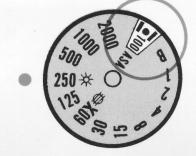 |
1 . Lift up the outer ring of the Shutter Speed/ ASA Speed Selector and turn
it until the number you want appears in the Film Speed Window. The film speed is
printed on the film box. (FUJICOLOR N100, FUJICHROME R100 and FUJIPAN SS are ASA
100 films).
2. The details of the ASA Speed Selector are illustrated below.
|
SELECTING THE SHUTTER SPEED
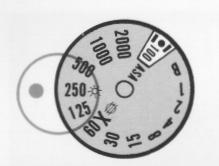 |
1. The numbers 1, 2, 4, etc. to 2000 on the Shutter Speed Selector stand for
1 sec., 1/2 sec., 1/4 sec. etc. to 1/2000 sec. B stands for bulb. It means that
the shutter will remain open for as long as the Shutter Release Button is
depressed. It is used for shooting with a shutter speed of 2 seconds or slower.
The X opposite the number 60 means that the Shutter Speed Selector Dial must be
set at this speed when shooting with electronic flash.
|
2. The exposure meter is controlled by the shutter speed and
lens aperture.
Exposure determination is always easier when the Shutter
Speed Selector is set first. The recommended shutter speeds for shooting in
bright daylight and under a cloudy sky are from 1/60 sec. to 1/250 sec.
respectively. The respective symbols ( sunshine - cloud icons ) are engraved
opposite the numbers as a reminder.
3. To set the shutter speed, just turn the Shutter Speed Selector until the
number you want click-stops opposite the Shutter Speed Mark (red dot on the
camera body).
4. Since different combinations of lens aperture and shutter speed can give
equivalent exposures, best results are obtained by using the combination that is
ideal for the picture you are taking. For example, if you are shooting a
fast-moving subject, use a fast shutter speed with a large lens aperture and if
you are shooting a subject having considerable depth, use a slow shutter speed
and stop the aperture far down.
Equivalent Exposures Example
|
Shutter speed
|
1/500
|
1/250
|
1/125
|
1/60
|
1/30
|
1/15
|
1/8 |
|
Exposure
|
1.4
|
2
|
2.8
|
4
|
5.6
|
8
|
11
|
5. To avoid camera movement, use a tripod and a cable release for shooting
with a shutter speed of 1/30 sec. or slower.
A cable release with stopper
is available for shooting with the Shutter Speed Selector set at B. The stopper
will keep the shutter open for as long as you wish.
FOCUS THE LENS
The Viewfinder is provided with an eyepiece for those with normal vision. If
you are near-sighted or far sighted, be sure to use an Eyesight Adjustment Lens,
otherwise it will be extremely difficult for you to focus the lens precisely.
Four different Eyesight Adjustment Lenses are supplied as optional accessories:
+2, +0.5, -2.5 and -4 dioptor.
(1) Look through the Viewfinder and point the camera so that
the main subject is seen through the small microprism center spot.
(2)Split-image Focusing
Turn the Focusing Ring until the upper and lower
segments of the split image in the microprism center spot converge to form a
single image.
(3) Microprism Focusing
Turn the Focusing Ring until the image in the
microprism center spot appears sharp.
(4) You can also focus with any part of the area surrounding the microprism
center spot. This method is especially useful when shooting with aperture
stopped far down.
(5) The white numbers on the Focusing Ring are for meters and the green
numbers are for feet. The distance can also be set by visual judgment for quick
shooting. When shooting extreme close-ups, the distance from subject to Film
Plane Indicator must be precisely measured with a tape measure.
EXPOSURE CONTROL
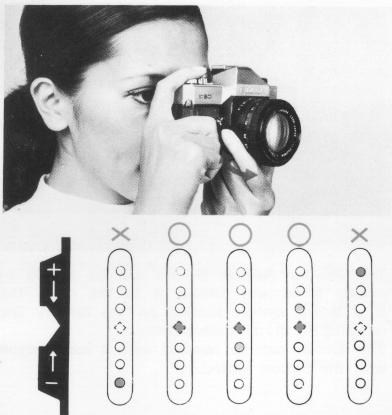 |
1. Look through the Viewfinder and touch the Shutter Release Button very
lightly. You will see 1 or 2 diode lights in the right hand side.
2. Turn the Aperture Selector Ring until the diode light opposite the center
of the Exposure Indicator is turned on. Even if you see 2 diode lights, center
and above center or center and below center, you will have the correct exposure
if the brightest one is the center light.
3. You will occasionally see 3 diode lights at the same time (especially when
shooting under fluorescent light, or when shooting wide open scenes in bright
sunlight), but the brightest light is always the main light. When the brightest
light is brought into the center of the Exposure Indicator, you have the correct
exposure.
|
 |
4. If the diode light is seen above center
(+ side) of the Exposure Indicator and you cannot move it to the center
(opposite the bottom of the V), by turning Aperture Selector Ring, the shutter
speed will have to be increased. If the diode light is seen below center (-
side) and you cannot move it to the center with the Aperture Selector Ring, the
shutter speed will have to be reduced. |
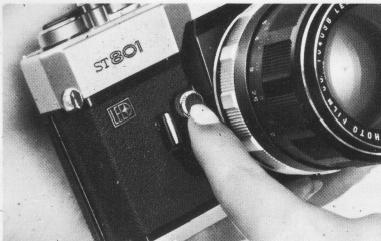 |
5. If you are using a lens other than one of the Fujinon interchangeable
lenses designed for the ST801, the light is measured through the stopped down
aperture.
First press down the Depth of Field Button and lock it by turning it to the
left. Next, touch the Shutter Release Button very lightly and turn on the diode
light located in the center of the Exposure Indicator by turning the Aperture
Selector Ring. (The diode light will not move unless the Depth of Field Button
is depressed).
|
Note: The diode light will not change unless the camera lens is properly
mounted and locked.
SUTTER RELEASE BUTTON LOCK
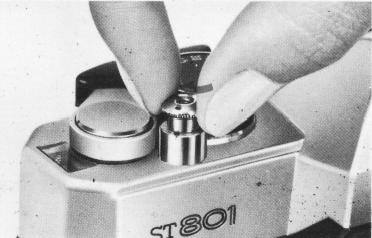 |
The Shutter Release Button can be locked by
pulling it up and turning it to the right. This . is a safety against turning on
the battery and releasing the shutter inadvertently. The shutter can be released
with a cable release with the button locked. |
REWIND AND UNLOADING THE FILM
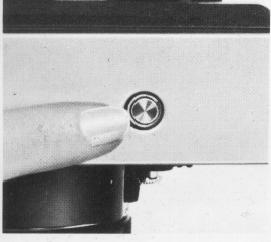 |
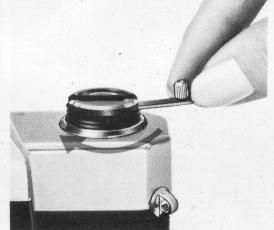 |
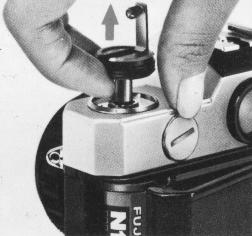 |
| 1. Press in the Film Rewind Button. |
2. Unfold the Film Rewind Crank and turn it
in the direction of the arrow. The crank will suddenly feel light when the
entire roll of film has been rewound. |
3. Next, lift the crank up to open the
Camera Back, unload the cartridge and send it to a processing laboratory as soon
as possible. |
NOTES:
1. Do not open the Camera Back until the film has been
completely wound back into the cartridge.
2. If the end of the film is reached when the Film Advance Lever is wound
only halfway around, do not force it through, because the film might break. Just
push it back to its normal position, and rewind the film into the cartridge.
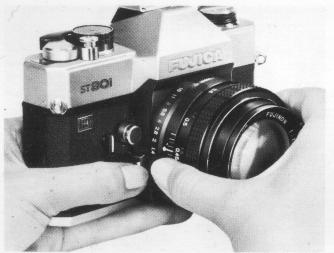 |
Your FUJICA ST801 takes a complete series of
FUJINON interchangeable lenses specially designed for this camera. It will also
take the interchangeable lenses for the FUJICA ST701 as well as any other lens
with a Praktica thread mount. With an adaptor on, it will also take lenses with
a Leica mount. However, with lenses other than those designed specially for the
camera, the light is measured through the stopped down aperture.
Using Fujinon Interchangeable Lenses.
1. To remove a lens, push back the Lens Safety Lock Release Button in the
direction of the arrow and turn the lens barrel to the left (counterclockwise).
Just 2 1/2 complete turns will release the lens.
2. To mount, just screw the lens in turning it clockwise until it stops with
a click.
|
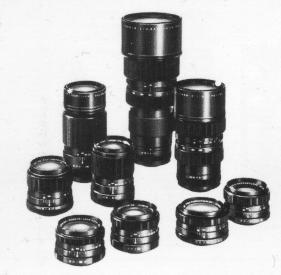 |
OTHER LENSES
1. To mount, screw the lens in until it feels tight and the
Distance/Aperture Indicator on the lens comes directly on top. About 2'/z-3
complete turns should be enough. If the Indicator on the lens is not directly on
top, the aperture might not operate.
2. To remove, just turn it to the left. (counterclockwise)
NOTES:
(1) Do not press in the Depth of Field Button when changing lenses.
(2) Avoid touching the lens glass and camera mirror with your fingers when
changing lenses.
|
CLICK TO ENLARGE IMAGES
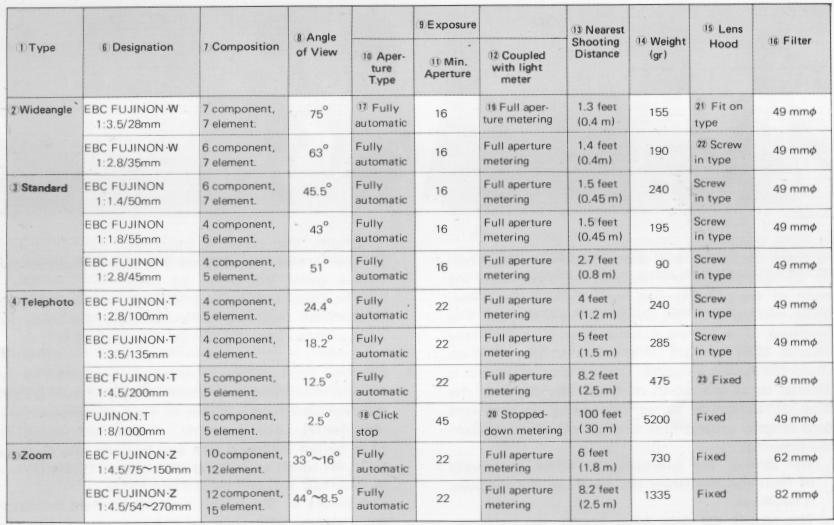
DEPTH OF FIELD
1. WHAT IS MEANT BY DEPTH OF FIELD
To check the effects of a selected
aperture-how well the background is blurred out or how wide the depth of
sharpness is-just look through the Viewfinder and press in the Depth of Field
Button. The sharpness of a picture extends over a considerable distance both in
front of and behind the point on which the lens is focused. This zone of
sharpness is referred to as the depth of field. The depth of the zone of
sharpness varies depending on the lens focal length, subject-to-lens distance,
and lens aperture-opening.
1. The smaller the aperture, the wider the depth of field and the larger the
aperture, the narrower it becomes.
2. The longer the lens focal length, the narrower the depth of field and the
shorter the focal length, the wider it becomes.
3. The farther the distance the lens is focused on, the wider the depth of
field.
4. The zone of sharpness in front of the point of sharpest focus is narrower
than the zone of sharpness behind the same point.
2. HOW TO USE THE DEPTH OF FIELD INDICATOR
All the interchangeable
lenses of the FUJICA ST801 are provided with a depth of field indicator on
the lens barrel. For example, if you are using an F1.8 55mm standard lens
and have set the distance at 16.4ft.(5m), everything from about
11.5ft.(3.5m) to 28.5ft.(8.7m) will be in sharp focus.
The colors of the ST801's depth of field indicator are matched with those of
the aperture numbers to simplify checking of the depth of field.
EXPOSURE COMPENSATION
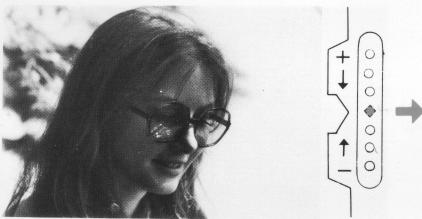 |
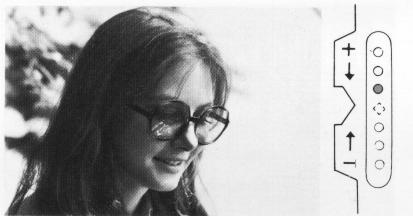 |
1. BACKLIGHTED PORTRAITS
1. Shoot with the diode light one stop
above the center indicator.
2. Move the diode light to the center of the Exposure Indicator, open up the
aperture by '/-stop or 1 full stop and shoot.
3. Move up close to the subject until it fills up the viewfinder and bring
the diode light into the center of the Exposure Indicator. Next, step back to
the right shooting distance and shoot.
|
2. PHOTOCOPYING
Printed matter on white paper will turn out
underexposed unless some exposure compensation is made.
1. Shoot with the diode light one stop above center.
2. Move the diode light to the center of the Exposure Indicator, open up the
aperture by 1 full stop and shoot.
3. Use an 18% reflectance gray card to measure the light reflected from the
subject.
|
|
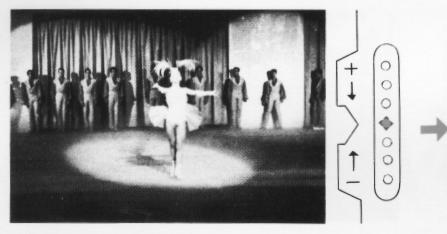
|
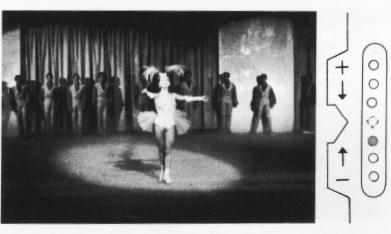 |
| 2. SPOT-LIGHTED SUBJECTS AND DARK
BACKGROUNDS
1. Shoot with the diode light one step below center.
2. Move the diode
light to the center of the Exposure Indicator, close down the aperture by
1/2-stop or 1 full stop and shoot.
|
3. Move up close to the subject, bring the diode light into the center of the
Exposure Indicator, step back and shoot. Note
NOTE:
(1) To achieve special effects with backlighted and other
specially lighted subjects, the picture is often taken without exposure
compensation.
|
4. SHOOTING BEYOND THE RANGE OF THE EXPOSURE METER (CLICK TO ENLARGE
IMAGE)
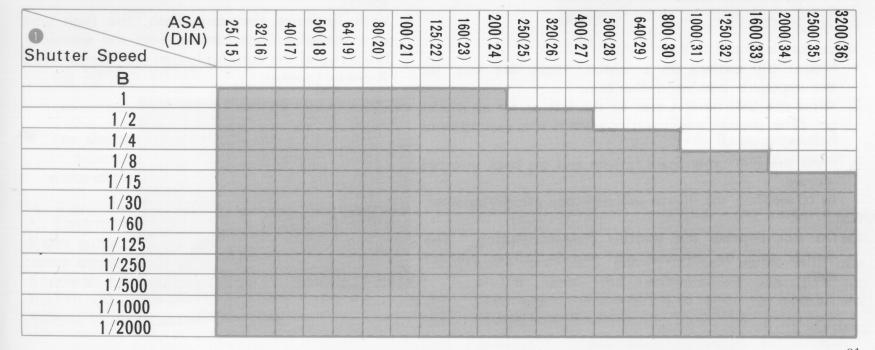
1. Although the ST801's light measuring
range is exceptionally wide EV1-19 (F1.4, 1 sec. to F16, 1/2000 sec. ASA 100 ),
the diodes will not respond if the light is too dim or if an extra-high speed
film is exposed with a slow shutter speed. (Example: ASA 800 film, 1 sec.
shutter speed). If the light is too dim, use supplementary lighting, and if you
are using an extra-high-speed film, use the proper shutter speed.
SELF-TIMER
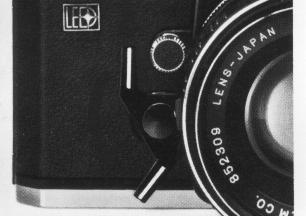 |
TO PICTURE YOURSELF
1. Mount the camera on a tripod,
focus the lens, set the exposure and wind the lever.
2. Wind
the Self-timer Lever to the left as far as it will go. (The shutter might not
operate if it is wound only halfway around).
3. Press the Self-timer Start Button and get back into the picture. In 10
seconds, the shutter will be automatically released. Note
(1) Do not depress the Shutter Release Button. The shutter will be released
and the Self-timer will not start.
|
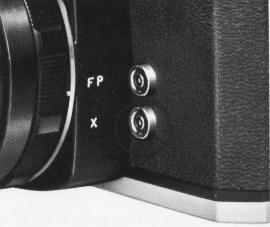 |
USE OF FLASH
You can use a flash for shooting indoors and night pictures as well as for
supplementary lighting in outdoor photography.
1. Electronic Flash
1. With a cordless, hot-shoe type electronic flash, all that is necessary is
to mount it on the camera's hot-shoe.
2. With other types of electronic flash, the flash unit is mounted on the
camera's hot-shoe and the cord is plugged into the camera's X-contact socket.
3. With large-size electronic flash, the flash unit is mounted on the camera
with the accessory bracket Mount the camera on a tripod, focus the lens, set
racket and the cord is plugged into the camera's X-contact socket.
|
4. In each case, the shutter speed is set at 1/60 sec. (marked with an X on
the Shutter Speed Scale).
2. Flash gun
1. The flash cord is plugged into the camera's
FP-contact socket.
2. An FP-class bulb is used on the firing unit.
3. Synchronizing Ranges

4. Exposure
1. Electronic Flash
Flash guide number divided by subject-to-film distance equals aperture.
Example: Electronic Flash (Guide No. m18/ ft. 60) FUJICOLOR N100, FUJICHROME
R100, FUJIPAN SS Subject-to-film distance=3m/10ft:

2. FP Flash Bulb
Since the flash guide number varies with the shutter speed, the recommended
procedure for determining the aperture is to follow the instructions packed with
the flash.
INTERCHANGEABLE LENSES AND ACCESSORIES
|
1. FUJINON•T 1:8 f=1000mm
2. EBC FUJINON•Z 1:4.5 f=54-.-270mm
3 EBC FUJINON•Z 1:4.5 f=75-150mm
4. EBC FUJINON•T 1:4.5 f=200mm
5. EBC FUJINON-T 1:3.5 f=135mm
6 • EBC FUJINON•T 1:2.8 f=100mm
7. EBC FUJINON 1:1.4 f=50mm
8• EBC FUJINON 1:1.8 f=55mm
9. EBC FUJINON 1:1.9 f=55mm
10• EBC FUJINON•W 1:2.8 f=35mm
11. EBC FUJINON-W 1:3.5 f=28mm
12• EBC FUJINON 1:2.8 f=45mm
|
ACCESSORIES
13. Lens hood for 100 and 135mm lenses
14. Lens hood for 50 and 55mm lenses
15. Lens hood for 35mm lens
16. Lens hood for 28mm lens
17. Eyesight adjustment lens
18. Lens cap (Front)
19. Lens cap (Back)
20• Body mount cap
21• Case
22. Microscope adapter
23. Macrocinecopy
24• Extension bellows
25• Q Setter
26• Extension tubes
27• Right angle finder
28• Eye cup
29• Close-up lens
30. Reverse adapter
31. Leica mount adapter
|
AVAILABLE LENSES
